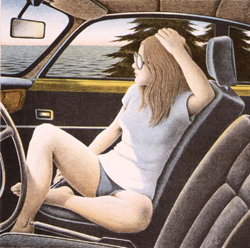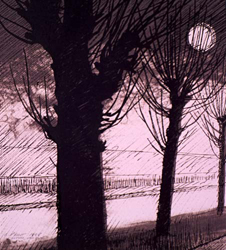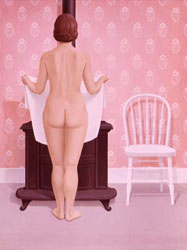

|
Figures  Why
is the human figure portrayed in art? Why
is the human figure portrayed in art?What do you think about Christopher Pratt's figure works? Do you think only about what you see? Do you wonder about what the model is looking at or thinking? There are viewers who just look without thinking of questions to ask. When nude figures are the subject in art, there does not seem to be any questions to ask because all is exposed. What do you think about the proportions of this figure? What do you think about your own proportions? When we say "we have things in proportion," we mean that we have achieved a balanced relationship of the parts to the whole. When things are proportionate, the view has a sense of satisfaction that the subject is rendered "correctly". Christopher began drawing from models, both male and female, at the Glasgow School of Art. Trained as a painter in the old European tradition, much of his studio time was dedicated to drawing from life that is, making drawings from studying nude models. Why do you think this subject of nude figures remains an important tradition?  Let's imagine you attended
a school that taught in the traditional artistic style but you were only
interested in painting landscapes. It would be essential for you to know
how to draw the proportion of the human figure to be an artist. Since
the fifteenth century, it has become a central tradition in Western art
for an artist to be able to draw the human figure well. Why is this so? Let's imagine you attended
a school that taught in the traditional artistic style but you were only
interested in painting landscapes. It would be essential for you to know
how to draw the proportion of the human figure to be an artist. Since
the fifteenth century, it has become a central tradition in Western art
for an artist to be able to draw the human figure well. Why is this so?One of the reasons is that human proportions and gestures are immediately identifiable to everybody who views the artwork. Viewers will be able to detect if, and what part of, a figure is drawn incorrectly by referring to their own bodies. Consider this scenario: an artist was to draw two memory images, one of a nude figure and the other of a tree. Would it be more difficult for the artist to draw a convincing image of a figure than it would be to draw a well-proportioned tree? Christopher can draw images of houses, rooms, and furniture by pulling these images from a reservoir of memories but he requires the assistance of a model when he plans to include a figure in a picture. His early figure images did not specifically identify the models as his later drawings did. If you attended a school that taught in the traditional artistic style but you were only interested in painting landscapes, it would still be essential for you to know how to draw the human figure before you would be considered a painter. Since the fifteenth century, it has become a central tradition in Western art for an artist to be able to draw the human figure well. Why? One of the reasons is that human proportions and gestures are immediately identifiable to everybody who views the artwork. Viewers will be able to detect if, and what part of, a figure is drawn incorrectly by using their own bodies to compare with. If an artist were to draw two memory images, one of a nude figure and the other of a tree, it would be more difficult for him or her to draw a convincing image of a figure than it would be to draw a well proportioned tree. Pratt is able to draw images of houses, rooms, and furniture by pulling these images from a reservoir of memories but requires the assistance of a model when he plans to include a figure in a picture. His early figure images did not specifically identify the models as his later drawings did.  For instance, the figure in the 1963 painting, Woman At Stove
(1962), represents an ideal form, not a portrait of the person
who posed in the studio. The figure in the 1984 drawing,
Girl Turning Away however, is a personal study of who Bernadette the
model is. This change occurred when Pratt began thinking of the individuality
of the person who was posing for him as the subject of the painting, as
opposed to thinking of the painting as an idea in which he needed to place
a figure.
For instance, the figure in the 1963 painting, Woman At Stove
(1962), represents an ideal form, not a portrait of the person
who posed in the studio. The figure in the 1984 drawing,
Girl Turning Away however, is a personal study of who Bernadette the
model is. This change occurred when Pratt began thinking of the individuality
of the person who was posing for him as the subject of the painting, as
opposed to thinking of the painting as an idea in which he needed to place
a figure.Pratt's ability to draw the figure well gave his work an added measure of credibility. There are specific guides of measurements that apply to the proportions of the ideal human form that have been in existence since the fifteenth century. These universal measurements dissect the human form into exact proportions. Guides to the proportions of the face can be found in the activity section. return
to You Try |
